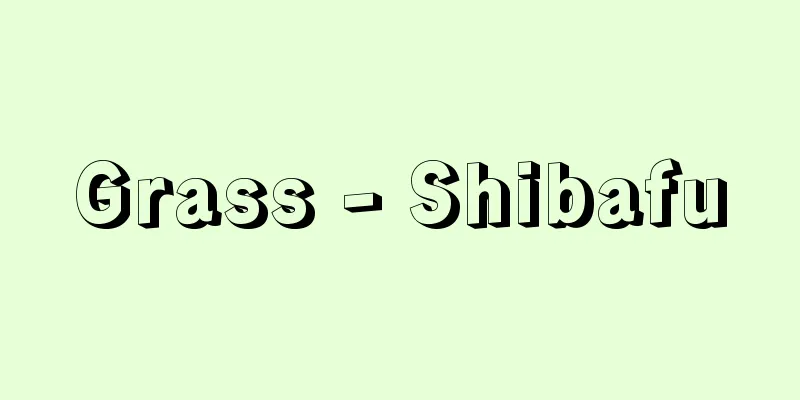Grass - Shibafu

|
It refers to a place where herbaceous plants for lawns (lawn grass or turfgrass) are planted for the purpose of ornamental purposes, rest, exercise, retaining soil, etc. Places where turfgrass is cultivated for production are sometimes called lawns, but these should really be called lawns or turf fields. Lawns have appeared in literature since ancient times, and in the Manyo period, they were written as shiba or shiba. Later, they were used to mean a plant with many fine leaves, and it is said that if it was a tree, it was called shibaki, and if it was grass, it was called shibakusa. There is also a theory that it means "grass with lush leaves," but this is not certain. Lawns are used for landscaping the sides of artificial hills and ponds, for composing gardens in ordinary homes, and for parks, green spaces, and sports fields that are necessary for civic life, as well as for preventing the collapse of slopes such as rivers and roads, and for protecting the ground surface. [Yasuo Hori] History of useIt is said that lawns were laid in gardens in Europe during the Roman period, but the grass used was a different type of pasture grass from the Japanese grass family. In Japan, it is said to have been used in landscaping during the Heian period, and there is a description of this in the Sakuteiki. In the Edo period, it began to be used by the upper classes as a garden material for artificial hills. In the Meiji period, when foreigners began to live in Japan, lawns were widely used in Western gardens and parks, and became widespread. [Yasuo Hori] Types of ShibaIt is broadly divided into Japanese grass and Western grass. [Yasuo Hori] Japanese grassIt is a type whose leaves die in winter. It is a robust, highly reproductive grass that can withstand trampling, and grows in the summer (summer type). (1) Korean lawn grass: This is the most common type of turfgrass planted. It has soft tips and thin, shiny leaves. (2) Velvet Zoysia Grass It is smaller than Korean Zoysia Grass. Its leaves are thin and it can withstand pruning and drought, but it is weak to cold. (3) No (wild) Lawn grass: A wild grass that grows in the mountains and fields of Japan. Its leaves are wider and stiffer than the two above, with pointed tips and long hairs on both sides of the leaves. [Yasuo Hori] Western GrassMost of them are pasture grasses or improved varieties of the same kind, and when used, one type may be used alone, or two or three types may be mixed together. In addition to bluegrass, bermudagrass, and bentgrass, several other types are in practical use. Unlike Japanese grasses, most of these Western grasses are evergreen, but as they grow vigorously and many reach heights of over 30 cm, they require frequent maintenance such as mowing. They are mainly used on golf courses and to protect steep slopes. [Yasuo Hori] Creating a lawnTurfgrass ProductionJapanese grass is shipped as cut grass with the soil still attached. When planting Japanese and Western grasses (laying turf), it is essential to meet three conditions for growing beautiful turf grass: sunlight, soil quality (clay and gravel are unsuitable), and drainage (poor drainage will cause root rot). There are two methods: the Harishiba method, in which the turf grass is planted in stripes in a tilled and fertilized field (turf field), and the Makishiba method, in which seeds are sown and grown; the former is more common. The planting site is plowed deep (20-30 centimeters) to allow the roots to spread sufficiently, and fertilizer (chemical fertilizer, 10-30 grams per square meter) is mixed in at the same time to level the soil surface. Pebbles and wood chips in the soil are removed beforehand, and the turf grass is laid after the soil has settled. [Yasuo Hori] TurfingThere are four different methods for laying grass when creating a lawn: (1) Flat laying: Cut grass is laid in a line without any gaps, and once all the new shoots have sprouted, it becomes a lawn. (2) Joint laying: This method of laying cut turf involves leaving a few centimeters between each piece, and the gaps are called joints. (3) Checkerboard laying: This method involves removing every other piece of cut turf from a flat laying to create a checkerboard pattern, and requires only half the amount of turf as in a flat laying. (4) Row laying: This is a method of laying cut grass in a single row, and is mainly used on slopes. It is often laid horizontally along contour lines. When laying turf, if the cut grass is left floating, it will not take root well (take root) and the creeping stems will not develop, so the grass must be pressed down so that it is in close contact with the soil. Also, when laying on a slope, bamboo stakes are made to hold the turf in place. Once the turf has been laid, it is covered with fine, light granular soil. This is called topsoil, and helps the turfgrass to take root. After applying the topsoil, water thoroughly. Topsoil should be applied once a year, preferably in March. [Yasuo Hori] Grass fieldThe Japanese grass used for laying turf is grown in turf fields and cut to a certain size. This is called cut turf, and is generally traded under the production standard of shiba tsubo. This assumes that a lawn laid over an area of 5 shaku square (approximately 2.3 square meters) is 1 tsubo (3.3 square meters), and 40 cut turf sheets (each sheet is 37.5 cm x 15 cm) make up 1 tsubo. Therefore, if laid flat, only 2.3 square meters can be laid. Note that the area of 1 tsubo cut up is called hon tsubo (1 cut turf sheet is 45 cm x 30 cm), but this is only used for slopes and retaining walls in mountainous areas. Western grasses are often planted from seeds. They grow beautifully as soon as they sprout, so they are used on golf courses and plazas that stay green all year round. In recent years, they have been improved, and the Tifton variety, developed at the Coastal Plain Agricultural Experiment Station in the United States, is beginning to be used for general lawns as well, as it grows quickly and is durable. [Yasuo Hori] Lawn Care(1) Mowing The grass becomes unsightly if the stems and leaves grow too long, so this is an important task for keeping the grass dense. During the growing season from April to October, mowing should be done two or three times a month. Lawn shears or a sickle will do, but if the area is large, it is more efficient to use a lawn mower (a rotary type is best for home use). However, during the hot, dry period of midsummer, mowing too hard can impair growth. (2) Fertilization Grass grows vigorously and consumes a lot of nutrients, so apply a thin liquid fertilizer or a small amount of chemical fertilizer once or twice a month while it is growing. Fertilizer should contain the three major elements (nitrogen, phosphorus, and potassium) plus trace elements. For an instant solution, dissolve about 30 grams of urea in 10 liters of water and spread it with a watering can, or you can spread about 30 grams of chemical fertilizer per square meter. (3) Weed control: Weeds other than turfgrass (such as plantain, white clover, rice bran, and annual bluegrass) tend to grow in the lawn. If weeds grow too thickly, the growth of the turfgrass will be reduced, so weeding is an important task. In addition to hand removal, weeding can be done by spraying herbicides. (4) Pest control The main pest is rust disease, which occurs during the rainy season, and the larvae of scarab beetles that feed on the roots. Pesticides are sprayed regularly. (5) Watering: In summer, the high temperature and dryness of the air will slow growth and cause the leaves to lose color, so it is important to provide the soil with sufficient moisture. (6) Topsoil Covering the base of the grass with new soil will help the grass take root and become stronger. Use topsoil that does not contain weed seeds, pebbles, etc. (7) Drilling holes in the lawn. As the lawn ages, the air in the soil becomes less and the roots do not take hold as well as the soil drains better. To prevent this, a tool is used to drill holes (spikes) in the soil to allow air to enter. (8) Others If the cut grass leaves are left to pile up, they will hinder growth and encourage the occurrence of pests and diseases, so remove the cut grass leaves with a rake and keep the area clean. Also, burning the grass in February and then applying topsoil will help promote beautiful sprouts and also help prevent pests and diseases. [Yasuo Hori] "Turfgrass and Turfland, 2nd Revised Edition, by Kaoru Ehara (1988, Yokendou)" ▽ "The Latest Turf and Turfgrass Research Methods, edited by the Japanese Turfgrass Society (2001, Soft Sciences)" [Reference item] | |©Shogakukan "> How to lay grass Source: Shogakukan Encyclopedia Nipponica About Encyclopedia Nipponica Information | Legend |
|
芝生用の草本植物(シバまたは芝草)を、観賞、休養、運動、土止め等の目的で植栽した場所をいう。芝草を生産用に栽培している場所も芝生とよばれることがあるが、これは本来、芝地、芝原とよばれるべきものである。シバは古くから文献に登場し、万葉の時代には柴、志婆などの文字があてられた。その後、葉が細かくて多い植物の意味に用いられ、木ならばシバキ、草ならシバクサとよんだともいわれる。また、「繁葉(しばは)草」の意味をもつとの説もあるが、さだかではない。芝生は築山(つきやま)池畔の造園や一般家庭の庭の構成用、市民生活に必要な公園、緑地、運動場に利用されるほか、河川、道路等の傾斜面の崩壊防止、地表面保護に役だっている。 [堀 保男] 利用史ヨーロッパではローマ時代に庭園の芝張りが行われたといわれるが、その材料の芝草は日本のイネ科のものとは異なった牧草類ともいわれる。わが国では平安時代に造園に利用されたともいわれ、『作庭記』にそれらしい記述がみられる。江戸時代に入ると、庭園材料として上流階級の間で築山に利用されるようになった。明治時代に入って外国人が居住するようになると、芝生は西洋庭園や公園にも盛んに利用され、一般に広まった。 [堀 保男] シバの種類日本芝と西洋芝に大別される。 [堀 保男] 日本芝冬に葉が枯れる種類である。性質は強健で繁殖力も強く、踏圧にも耐えるイネ科植物で、夏が生育期である(夏型)。 (1)コウライ(高麗)シバ 植栽されている芝草のなかでもっとも多い。葉先が軟らかく、葉も細くて光沢がある。 (2)ビロードシバ コウライシバよりも小形である。葉は細く、刈り込み・日照りに強いが、寒さには弱い。 (3)ノ(野)シバ 日本の山野に自生する野生の芝草で、前記2種より葉幅が広く、粗剛で葉先がとがり、葉の両面に長毛がある。 [堀 保男] 西洋芝主として牧草類やその仲間の改良種が多く、利用に際しては1種類のみの単用使用と、2~3種を混合して使用する場合とがある。ブルーグラス類、バーミューダグラス類、ベントグラス類などのほか数種ほど実用に供されている。これらの西洋芝は日本芝と異なり常緑性のものがおもに用いられるが、成長が旺盛(おうせい)で草丈が30センチメートル以上にもなるものが多いので、たびたび刈り込みをするなどの管理作業が必要である。主としてゴルフ場や急斜面の保護に用いられる。 [堀 保男] 芝生の造成芝草の生産日本芝は土をつけたまま、切芝にして出荷する。日本芝、西洋芝の植え込み(芝張り)にあたっては、日照、土質(粘土質や砂利は不適)、排水(排水が悪いと根腐れをおこす)の3条件を整えることが、美しい芝草を育てるうえで肝要である。耕うん施肥された圃場(ほじょう)(芝畑)に芝草を筋状に植え付ける張芝(はりしば)法と、種子を播(ま)いて育てる播芝(まきしば)法があるが、前者が一般的である。根が十分張れるよう植栽地を深く耕し(20~30センチメートル)、同時に肥料(化成肥料1平方メートル当り10~30グラム)を混合して土表をならす。土中の小石や木片をあらかじめ除去し、土が落着いてから張り付ける。 [堀 保男] 芝張り芝生作りに際しての芝張りの手法には次の4種がある。 (1)平(べた)張り 切芝をすきまのないように並べて張り付ける方法で、新芽が出そろうと芝生になる。 (2)目地(めじ)張り 切芝を数センチメートルの間隔をあけて並べる張り方で、そのすきまを目地とよぶ。 (3)市松(いちまつ)張り 平張りの切芝を1枚置きに除いて市松模様に張る方法で、平張りの半分の量でまにあう。 (4)条(すじ)張り 切芝を1列に並べた張り方で、主として斜面に利用される。等高線に並べた横張りが多い。 芝を張るときは、切芝が浮き上がった状態であると活着(発根)が悪く、匍匐(ほふく)茎も発育しないので、芝草が土と密着するように押さえ付ける。また斜面張りには竹杭(ぐい)をつくり芝止めする。張り付けが終わったら細かく軽い粒状土をかけて覆土する。これを目土(めつち)といい、芝草の発根を助ける。目土をかけたら十分灌水(かんすい)する。目土は年1回、時期は3月がよい。 [堀 保男] 芝坪張芝に用いる日本芝は、芝畑で栽培されたものを一定の大きさに切り取って使用する。これを切芝とよび、一般に芝坪という生産規格で取引される。これは5尺平方(約2.3平方メートル)に張った芝生を1坪(3.3平方メートル)とみなすもので、切芝40枚(1枚が37.5センチメートル×15センチメートル)で1坪となる。したがって平張りすれば実質2.3平方メートル分しか張り付けられない。なお、真の1坪分を切り上げたものを本坪とよぶが(切芝1枚が45センチメートル×30センチメートル)、山地の法(のり)面や土止め工事で用いられるにすぎない。 西洋芝は、主として種子を播いて芝生をつくるものが多い。発芽と同時に美しい芝生となるため、一年中緑を保つゴルフ場や広場に利用される。近年改良が進み、アメリカのコースタルプレーン農業試験場で育成したティフトン系のものは、生育も早くじょうぶなため一般の芝生にも用いられつつある。 [堀 保男] 芝生の管理(1)芝刈り 茎葉が伸びすぎると見苦しくなるので、よく密生させるためには重要な作業である。4~10月までの生育期は月2、3回程度の割合で行う。芝刈り鋏(ばさみ)や鎌(かま)でよいが、広い場合はローンモーア(家庭用にはロータリー式がよい)を用いると能率的である。なお盛夏の高温乾燥期間は強く刈ると生育が悪くなることもある。 (2)施肥 芝草は生育が旺盛なだけに養分消費も多く、生育中は薄い液肥か少量の化成肥料を月1、2回施す。肥料は三要素(窒素、リン酸、カリ)に微量要素を加えたものがよい。即席としては尿素を10リットルの水に30グラム程度溶かして如露で散布するか、化成肥料を1平方メートル当り30グラム内外散布してもよい。 (3)雑草駆除 芝生には芝草以外の雑草(オオバコ、シロツメクサ、チドメグサ、スズメノカタビラなど)が生えやすい。雑草が密生すると芝草の生育が衰えるので、除草は重要な作業である。手取りのほか除草剤散布の方法もある。 (4)病虫害駆除 梅雨のころから発生するサビ病がおもで、害虫には根を食害するコガネムシ類などの幼虫がいる。定期的に農薬を散布する。 (5)灌水(かんすい) 夏季は高温乾燥のため生育が衰えて葉色が悪くなるので、土中に十分水分を補給してやる。 (6)目土入れ 新しい土で芝草の根元を覆ってやることで、根張りがよくなりじょうぶな芝となる。目土用土は雑草種子、小石などの混入していないものを用いる。 (7)芝地の穴あけ 年とともに芝地は固まって土中の空気が少なくなり、根張りや排水が悪くなるので、器具を用い土中に穴(スパイク)をあけて空気を入れてやる。 (8)その他 刈った芝葉が残って堆積(たいせき)すると生育を阻害し、病虫害の発生を助長するので、刈取り残葉は熊手(くまで)でかき取り、いつも清潔にしておく。また、2月ごろ芝焼きを行ってから目土をかけると、美しい芽出しに効果があり、病害虫駆除にも役だつ。 [堀 保男] 『江原薫著『芝草と芝地 第2増訂』(1988・養賢堂)』▽『日本芝草学会編『最新芝生・芝草調査法』(2001・ソフトサイエンス社)』 [参照項目] | |©Shogakukan"> 芝張りの方法 出典 小学館 日本大百科全書(ニッポニカ)日本大百科全書(ニッポニカ)について 情報 | 凡例 |
>>: Fu'ād Shihāb (English spelling)
Recommend
ABM - ABM
Anti-Ballistic Missile is a system that combines ...
Palaemon serrifer (English spelling)
… [Takeda Masatomo]. … *Some of the terminology e...
Planchette
...It is said that if a person born in the year o...
West End
A colloquial name for the area in the center of L...
Horse-killing
…It is a type of children's game, and althoug...
Millet - Awabo
〘Noun〙① Ears of millet. Awabou. [Season: Autumn] ※...
Joch
…overhangA rock that juts out like a eaves. It is...
SAP (Alloy) - SAP
…Duralumin, an aluminum alloy, is also known to h...
Caramelization reaction - Caramelization reaction
…When oil is heated, it turns brown due to oxidat...
Archaeopteryx macrura (English spelling) Archaeopteryxmacrura
… [Yoshikazu Hasegawa]. … *Some of the terminolog...
Single
…After the Renaissance, in Belgium, the Netherlan...
The Selling of Honor Incident
This case is also known as the Awards Bureau Scan...
Cuneiform writing - Cuneiform writing
Laws written in cuneiform on mud tablets. The ter...
Social solidarity (English spelling)
In general, it refers to the form of interaction b...
Schizaea dichotoma (English spelling) Schizaeadichotoma
…[Kunio Iwatsuki]. … *Some of the terminology tha...
![Kyrgyzstan [Autonomous Region] - Kirgis](/upload/images/67d07250e19d4.webp)








